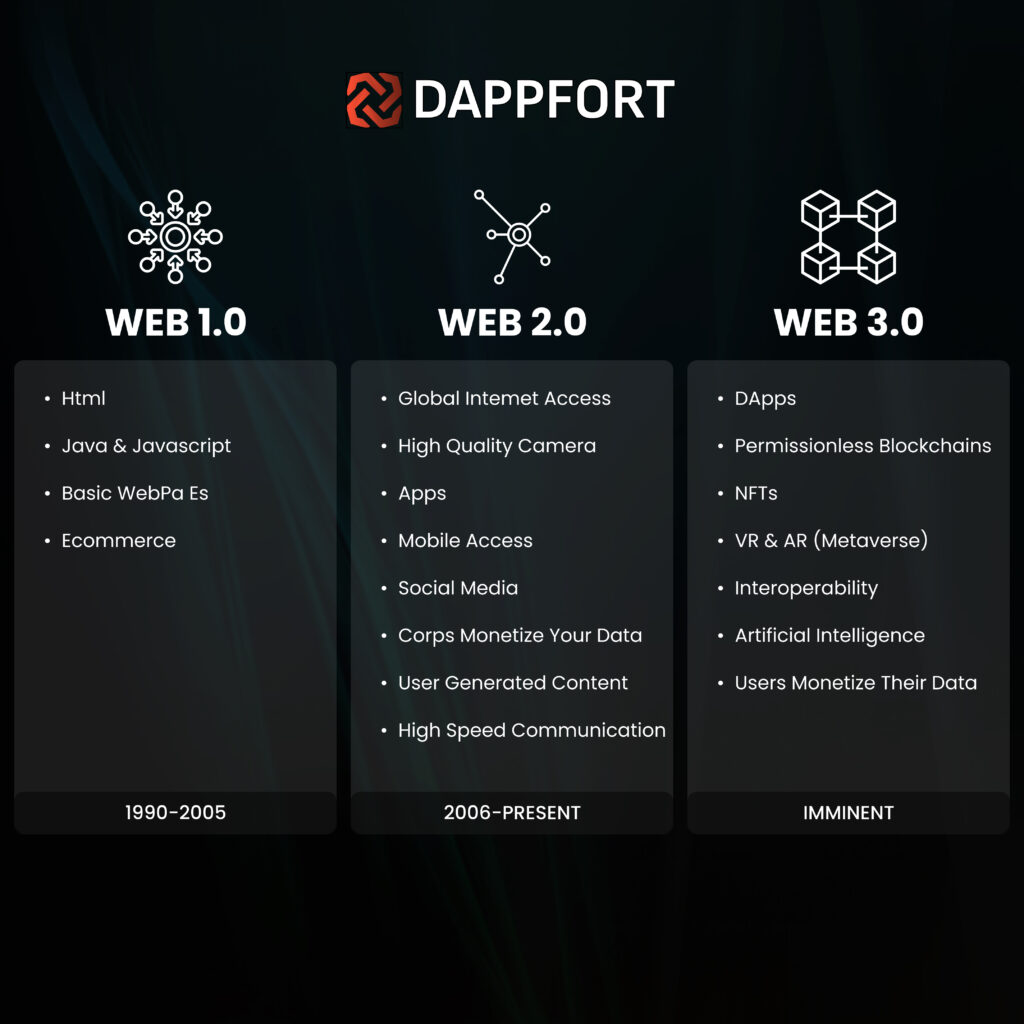Web2, or Web 2.0, is characterized by the centralization of data and content by a few big companies informally called “Big Tech.” In contrast, Web3 utilizes decentralized technologies to give data and content control back to online communities and regular people.
Web3, or Web 3.0 as it is sometimes called, is an idea for a new version of the World Wide Web based on blockchain development, token-based economics, and decentralization.
While the term Web3 was coined nearly a decade ago by Gavin Wood, co-founder of the Ethereum blockchain, it wasn’t until the last few years that the concept of Web3 development got more popular as technology companies and computer science enthusiasts showed greater interest in it.
The comparison between Web2 and Web3 highlights a significant evolution in the architecture, functionality, and user experience of the internet. Here’s a detailed comparison highlighting the key differences and implications of this transition.
Web2 vs. Web3: A Full Comparative Analysis
Centralization vs. Decentralization
Web2: Right now, most of the internet operates on a centralized model. This means companies like Google and Facebook hold all the cards—they own the servers, and they get to control the data. They decide what stays up, what comes down, and who gets access.
Web3: Web3 flips the script. Instead of everything being controlled by a few big players, it’s decentralized. The data is spread across lots of different places (thanks to blockchain), which means you have more say over what happens with your own information and content.

User Control and Ownership
Web2: When you post something online today—like a photo or a video—you don’t really own it anymore. The platform can delete it or change it, and there’s not much you can do.
Web3: you stay in control. You own the content you create, and no one can take that away. Blockchain ensures that your digital creations belong to you, and you can manage them however you like.
Data Privacy and Security
Web2: Ever wonder how your data ends up in a hack or why you see ads for things you just talked about? That’s because in Web2, your personal data is often stored in one place, making it vulnerable to breaches. Plus, companies track your activities to sell ads.
Web3: Its gives you better protection. Your data is distributed across a decentralized network, so hackers can’t just break into one system and steal everything. You also have more control over what information you share and how it’s used.
Transaction Speed
Web2: Transactions in Web2 are pretty fast. Since all the data is in one place, things get processed quickly.
Web3: Web3 is a bit slower, though. That’s because transactions need to be verified across a whole decentralized network, which can take time.
Transparency
Web2: If you’re using Web2 platforms, there’s often a lot going on behind the scenes you don’t know about. Your data could be used in ways you’re not aware of, and you rarely have a say in it.
Web3: Is much more transparent. You can see exactly how your data is being used and even have a chance to make money from it yourself.
Innovation and Ecosystem
Web2: In the current Web2 world, a few huge companies drive most of the innovation. This means we don’t see as much variety in services since the big guys set the rules.
Web3: Web3 opens up opportunities for everyone. Because it’s decentralized, anyone can build decentralized apps (dApps), leading to a more creative and diverse internet.
Censorship Resistance
Web2: In Web2, your content can be removed or censored by the platform, or even by governments. That raises a lot of questions about free speech and control.
Web3: With Web3, censorship is harder. It’s a decentralized system, so users have more control over their own content and are less likely to be silenced.
Monetization Models
Web2: Web2 platforms mostly make their money through ads, and they do this by using your data. They profit from what you share without giving you any of the earnings.
Web3: In Web3, it’s different. You can actually earn from your contributions. With token-based systems, your participation can get you rewards, making it a more user-centered economy.
User Identification
Web2: In Web2, you usually log in using your personal details, like an email or social media account, which ties back to your real-world identity.
Web3: Web3 allows you to interact anonymously using just a wallet address. This means you don’t need to share personal information, enhancing your privacy.
Future Prospects
Web2 still rules the internet, but Web3 is catching up fast. It fixes a lot of the issues Web2 has, and with technologies like AI and IoT making their way into Web3 apps, the future of the internet looks more secure, dynamic, and user-centered.
To sum it up, moving from Web2 to Web3 represents a major transformation toward an internet that is more decentralized, secure, and focused on the user. This shift empowers individuals by giving them increased control over their digital lives.
If you’re looking for a Web3 development company to guide you through this new world and make the most of decentralized technologies, check out Dappfort . They focus on creating solutions that fit your business needs.



